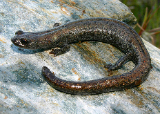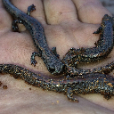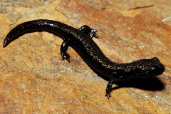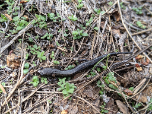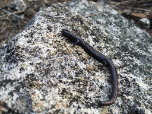 |
Kern Plateau Slender Salamander Range Map
|
|
|
 |
 |
 |
 |
 |
 |
 |
Kern Plateau Slender Salamander Juvenile
Want to Contribute a photo of a Juvenile Kern Plateau Slender Salamander?
Email Us
|
|
|
 |
 |
 |
 |
 |
 |
|
Kern Plateau Slender Salamander (Batrachoseps robustus)
Description: Adults are 1 3/4 to 2 1/4 inches long from snout to vent. A small slim salamander with 16 to 17 costal grooves. Short limbs, a long slender body with a narrow head and a long tail, and conspicuous costal and caudal grooves give this species the worm-like appearance typical of most Slender Salamanders. Relatively large and robust when compared with most Slender Salamanders, having a fairly broad head, long legs, broad feet, short tail, and large toes. There are four toes on the front and hind feet, which is also typical of Slender Salamanders. (Other California salamanders have five toes on the hind feet.) Color is rusty, bronze, gray, reddish, usually with a dorsal stripe and scattered flecks and spots. The venter is gray or black in color. The throat has heavy white mottling. Animals from dryer habitats have lighter coloring of gray or silver, while those from coniferous forest tend to match the darker environment with red and brown coloring.
Habitat: Its natural habitat is freshwater springs in the temperate coniferous forests and in higher Mojave Desert-Sierra forest ecotones.
Range: This salamander is endemic to three locations in the southern Sierra Nevada: in the upper Kern River's Kern Plateau; the western margin of the Owens Valley; and the Scodie Mountains, at elevations from 5,299 to 9,186 fteet.
Found in these States:
CA
Diet: Most likely eats a variety of small invertebrates. Feeding behavior is not well known, but other Batrachoseps species are sit-and-wait predators that use a projectile tongue to catch prey.
Reproduction: Little is known about the breeding behavior of this species. Reproduction is terrestrial. Breeding and egg-laying probably occurs in spring after snow-melt. All species of Slender Salamanders lay eggs, typically in moist places on land. Gravid females have been found in early May. Females in a lab laid three eggs. Eggs in the lab hatched in 96 to 103 days. Young develop completely in the egg and hatch fully formed. Hatchlings were black with gold or silver flecking measuring about a half inch in length from snout to vent (12 to 13 mm).
Status: Listed as Endangered because its extent of occurrence (EOO) is 2,874 km2, it occurs in five or fewer threat-defined locations, and there is continuing decline in the extent and quality of its habitat due to timber-harvesting, road construction and alteration of hydrology. Climate change is having an increasing impact on the habitat of the species, in particular because this species is reliant on moist habitats, and climate change is reducing the spring flows and potentially increasing flash flooding.
»» Kingdom: Animalia - Animals
»» Phylum: Chordata - Chordates
»» Subphylum: Vertebrata - Vertebrates
»» Class: Amphibia - (Amphibians)
»» Order: Caudata - Salamanders
»» Family: Plethodontidae - Lungless Salamanders
»» Genus: Batrachoseps
»» Species: Batrachoseps robustus - Kern Plateau Slender Salamander
This article uses material from the Wikipedia article "Kern Plateau Slender Salamander", which is released under the Creative Commons Attribution-Share-Alike License 3.0. Content may have been omitted from the original, but no content has been changed or extended.
|
|




